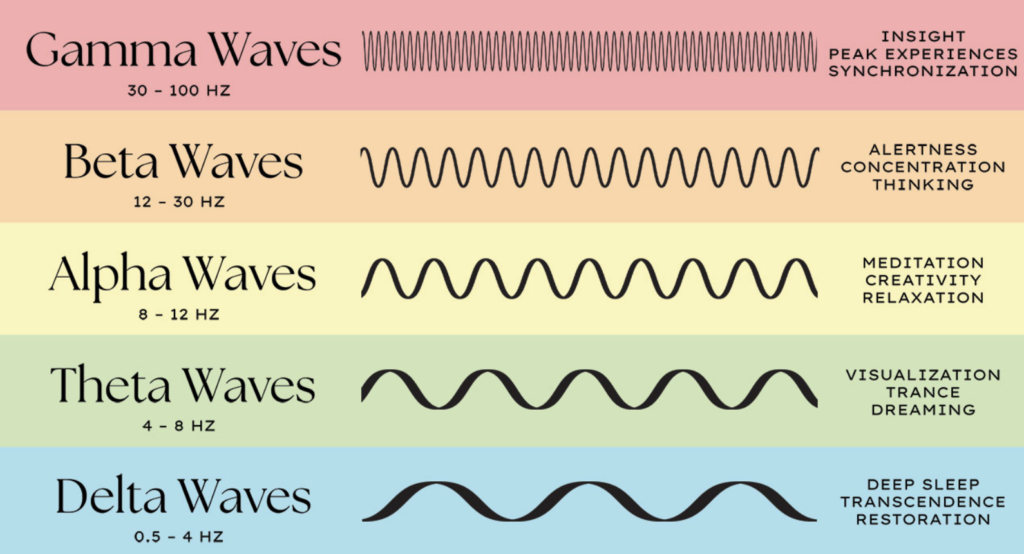
Surfing the Mind: How Brainwaves Affect Your Mood and Focus
We’re taking a trip back in time to 8th grade science class today to talk about brain waves. Although, back then it was more like “memorize the frequency ranges of gamma waves… blah, blah, blah” and a lot less “let’s understand how our brains work so we can become healthier and happier people”
I don’t know about you, but I probably would have paid a lot more attention had I known how I could hack my way into better focus, more connection with my intuition, and deeper relaxation…
So stick with me – this is a lot more exciting than waiting for the bell to ring…
Here’s the low down on brainwaves: Throughout the day, our brains fluctuate between 5 different wave patterns (which we can actually monitor using an EEG machine). Each pattern (or brainwave frequency) tends to align with a distinct mental state:
Gamma: Often present during tasks requiring a hefty dose of focus and cognition. So, when you’re deeply engrossed in learning something new, it’s likely gamma waves are at play.
Beta: These brainwaves are in the driver’s seat when we’re actively engaging with our environment, solving problems, or using logic and reasoning. However, if we’re continuously in this state, it can edge us towards feelings of stress, anxiety, and a sense of being overwhelmed.
Alpha: Picture your brain lounging on a hammock, physically relaxed and mentally unwinding. That’s when alpha waves are typically observed. In this state, anxiety may ebb away, paving the way for moments of inspiration, happiness, and motivation.
Theta: Ever find yourself zoning out during routine tasks or daydreaming? That’s theta waves for you. They are often linked to activities that have become so habitual that they don’t require active focus, like brushing your teeth or the familiar drive home.
Delta: This is the ‘night owl’ of brainwaves, predominantly active when we’re in the realm of deep, dreamless sleep. In this stage, your body is all about restoration and healing.

These brainwave patterns provide a fascinating glimpse into the workings of our minds at various moments. However, remember that our brains are not always solely in one ‘state.’ Often, several types of brainwaves coexist, but one tends to be more dominant depending on our activity or mental state.
And why should we care about these oscillations in our gray matter? Because by better understanding these brainwave states, we can potentially tap into ways to influence our own mental well-being. For example, if you need a creativity boost, maybe you’ll want to find ways to encourage more alpha wave activity. Or, if deep focus is what you’re after, finding strategies to foster beta wave activity might be beneficial.
Of course, the science is still evolving and it’s important to remember that our brains are complex and individual. What works for one person might not work for another. So, when exploring brainwave manipulation – whether through meditation, binaural beats, or some other method – it’s all about finding what resonates best with you and your mind.
TRY IT YOURSELF
When we’re feeling the overwhelm and need to rest, or when we’re feeling lethargic and want to focus, how can we nudge our brains into our desired frequency? Our options for how to change brain waves at will are plentiful: we can do it through meditation, music, activities that create a specific state of mind, or even what we drink (need that calm state? Tea should be your go-to!)
- Binaural beats: Research shows that your brain can change based on external stimuli. If you want to get into the beta brainwave state for focus and concentration, do a quick google for “Beta Binaural Beats” or if you desire deep relaxation, look for “theta binaural beats”, etc. and listen while you work or close your eyes.
(Quick health note: if you are a patient of epilepsy, consult your doctor before using binaural beat therapy).
- For Parents of littles: Kiddos between the ages of 0-7 spend most of their time in the Theta Brainwave state, which is highly suggestable and will inform their subconscious brain for the remainder of their lives. To help your kiddos form really strong lifetime values, don’t shy away from talking about big picture themes you hope to instill, now. @DrBeckyGoodInside is my go to for learning how to approach big conversations early that have long term effects.
- Study your neural feedback: There are more and more at-home neural feedback devices coming onto the market these days. One of my favorites is https://focuscalm.com/, but there are a ton out there. By gaining a deep understanding of your own brain waves with at home eeg devices, you’ll get more data about yourself and can use it to help with your own focus and calm.
FURTHER EXPRLORATION
Watch This: Ted talk by Tan Le, who is the founder & CEO of Emotiv, a bioinformatics company that’s working on identifying biomarkers for mental and other neurological conditions using electroencephalography (EEG).
Read Breaking the Habit of Being Yourself by Dr. Joe Dispenza is one of my all time faves. He takes the science behind our brains and weaves it seamlessly in a way that helps the reader understand how they can be the best version of ourselves by understanding how our minds work on a deep level.
Get academic: We know that yoga is good for our bodies, but this study goes deep into the cognitive effects practicing yoga, meditation and breathwork can have on your mind.
I hope this quick rundown piqued your curiosity on our brains a bit. And I promise – next time you need to get that deck down in two hours, pick up those headphones and head to Spotify for some beta beats and you’ll be golden.
Until next week, stay intentional about what you pay attention to.

June 28, 2023
Be the first to comment